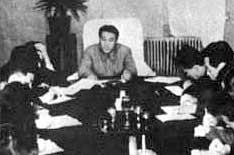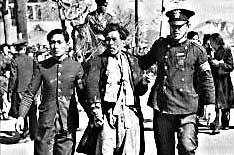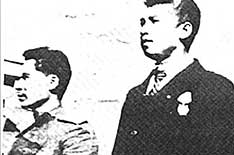North Korea’s roots lie deep in Korean history.
For years, Korea had contained one of Asia’s most active set of communist groups and activists. Leftist activists had gone to Manchuria to fight the Japanese and to China to fight with Mao Zedong against Chiang Kaishek. During Japan’s 35-year occupation of the Korean peninsula (1910-1945), these same organizations had worked underground to reestablish Korea’s independence.
In 1945, Korea was faced with a new set of foreign occupiers: Soviet forces in the north, American forces in the south. Ironically, the line chosen by the U.S. State Department to separate the two — the 38th parallel — was the same boundary used by Japan and Russia in the early part of the 20th century to stake out areas of influence on the peninsula. As in the past, no Koreans were consulted.
At war’s end, among the thousands of Koreans returning home from China, Manchuria, or the Soviet Union was Kim Il Sung, a Soviet army captain. Kim, raised in Manchuria, had fought against the Japanese in Manchuria and northern Korea since his early 20s, first with a band of Korean guerillas, then with the Chinese army, and, finally, since 1941, from a Soviet training camp near Khabarovsk. Conversant in Chinese and Russian, the 33-year-old Kim had earned a reputation as a heroic guerilla commander.
When Soviet occupying forces formed a provisional government for northern Korea in early 1946, they chose the charismatic Kim to head it. Just over two years later, on September 9, 1948, three weeks after the formation of the Republic of Korea to the south, he would be named premier of the Democratic People’s Republic of Korea.
But Kim Il Sung displayed no intention of allowing the DPRK to become a mere Soviet satellite state. Though Soviet influences could be found throughout North Korea — particularly in the security forces, media, and the country’s arms trade — differences remained. Going against traditional Marxist-Leninist theory, the communist party in North Korea was a party of the masses, not the vanguard. Whereas Stalin had squashed ethnic nationalism in the Soviet Union, Kim wholeheartedly embraced Korean nationalism. The focus of North Korea’s national pride was the Korean People’s Army, charged in 1948 with taking the Korean guerilla campaign against the Japanese in Manchuria as its example.
Still, this was no soft socialism. Under Kim’s rule, sweeping land reform was enacted in 1946 that redistributed over 2 million acres of land in just a month. Industries were nationalized, women were guaranteed equality under the law, and political action cells were formed to “educate” the population.
By comparison with the more rural South, North Korea was economically well-endowed. With a far smaller population, it contained the bulk of Korea’s heavy industry, mining, and electricity plants (a fact that in the early days of the divide often led Pyongyang to cut Seoul’s electricity at will). Per capita productivity was booming.
Kim wasted little time in consolidating his hold over this budding socialist success story. Korean communists who had worked at home or in China, Manchuria, and the Soviet Union were integrated into his government, but, by 1949, Kim had overcome factionalism to be named “suryong” (“leader”) of the ruling Korean Workers’ Party. His mission was clear: unite Korea.
The United Nations only recognized the U.S.-backed Republic of Korea as legitimate, but Kim saw no reason to cede the field. By June 1949, both Soviet and American troops had withdrawn from the Korean peninsula. U.S. interest in South Korea appeared to be faltering: in a January 1950 speech, Secretary of State Dean Acheson omitted the country from a list of Pacific Rim states vital to U.S. defense interests. Meanwhile, in South Korea, President Syngman Rhee had unleashed a brutal campaign against suspected communists and leftists.
Force was Kim’s intended response, but first he needed support. Recently uncovered documents indicate that he headed to Moscow in early 1950 for consultations with Stalin about an invasion of the South. The Soviet leader gave cautious support to Kim’s invasion plan, contingent on an endorsement by China’s new communist leader, Mao Zedong. Traveling to Beijing, Kim got that approval.
For the North, it was time to act.
- Previous: Introduction
- Next: June 1950 War Breaks Out





